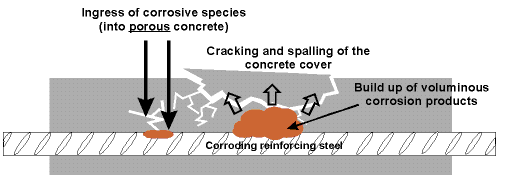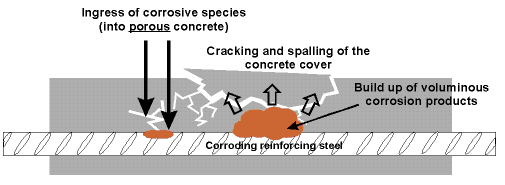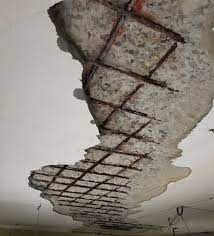Concrete spalling is one of the main problems that affect the durability of reinforced concrete structures. They can have many causes, which we will discuss in the last part of this article.
Spalling often occurs in older structures. They generally begin when the structure is between 10 and 20 years old. There are other signs that spalling is occurring, such as: B. Cracks in the concrete, increase in volume of the concrete, etc.
What is peeling?
When chipping, the material breaks into pieces. Concrete spalling involves parts of the concrete being separated from the main structure by cracks or expansion of the concrete.
In the initial phase, surface cracks form in the concrete and, over time, movement of the concrete surface can be observed. If this can be detected at an early stage, we can minimize damage to the structure.


Effects of Chipped Concrete
Spalling has a detrimental effect on structures. Therefore, special care must be taken to ensure that the structure is not damaged by splinters. The following points can be considered the main problems.
- Structure durability
When concrete and reinforcement are damaged, it affects the designed lifespan of structures. As a result, the durability of the structure decreases.
- Reducing structural strength
Damage to the concrete coverage zone does not significantly affect the strength of the component. However, reinforcement corrosion and concrete strength can significantly affect the load-bearing capacity of a component.
- Structural errors
If the strength of structural elements is compromised, structural failure may occur if this problem is not resolved in a timely manner and repair of the spalled concrete is not carried out in a timely manner.
- Chipping in expansion joints
Failure of expansion or movement joints may occur.
- Aesthetic appearance
When concrete spalling occurs, it affects the appearance of the structure.
Causes of concrete spalling
The causes of concrete spalling that lead to concrete spalling are varied.
Let's discuss each of the causes of concrete spalling.
- Freeze-thaw cycle
- road salt
- Poor finishing techniques
- Inadequate curing of concrete
Hardening of concrete is being done to improve durability of concrete and to prevent cracking in concrete . Inadequate curing can result in weak concrete in the deck zone, allowing moisture and air to reach the reinforcement. This leads to corrosion of the reinforcement and an increase in internal volume, resulting in concrete spalling.
If we Prevent corrosion If reinforcement were used, such failures could not occur.


- High temperature
Temperature fluctuations and increases in concrete throughout the day lead to cracks in the concrete. This can lead to the concrete detaching from the area covered by the reinforcement.
- Insufficient concrete compaction
Insufficient concrete compaction weakens the quality of the concrete and affects the durability and strength of the concrete. As a result, concrete spalling may occur.
- Fire exposure
In the event of a fire, the temperature of the concrete can rise to 7,000 °C. This value may depend on many factors. However, increasing temperature in concrete leads to concrete spalling.


- Reinforcement corrosion due to carbonation
Corrosion of reinforcement can be caused by carbonation, chloride and sulfate attacks. Corrosion of the reinforcement causes the internal column to increase around the reinforcement. The formation of corrosion-related cracks in a specific area causes the concrete to fragment.
- Reinforcement corrosion due to chloride attacks
- Reinforcement corrosion due to sulfate attack
- Expansive effect due to alkali-silica reaction
- Inadequate reinforcement coverage
Depending on the load condition of the structure, sufficient reinforcement coverage must be guaranteed. Failure to provide adequate coverage will result in corrosion of the rebar, resulting in spalling of the concrete.
In marine environments we keep the rebar covered to about 75mm and the tablets covered to about 100mm. For other structures where there are major environmental concerns related to the durability of the structure, coverage can be maintained in the range of 20mm to 50mm depending on the type of element and soil conditions.
- Poor quality concrete in the coverage area
- Bad concrete mix
- environment pollution
- High water-cement ratio
Repairing spalled concrete
There are three main categories of chip repairs. Namely the following:
- Repair chips by patching – prepare only the damaged area.
- Overlay Repair – Apply an overlay layer to the entire area.
- Replace completely.
Of the types of chip repair mentioned above, patch repair is the most common, as in the initial stages the concrete may only chip in certain areas. If we do not take action, the situation will worsen and we may have to perform an overlay or complete replacement.
- Properly clean concrete chips
- Completely remove loose concrete
- Clean the rebar. All rust must be removed and, if necessary, mechanical or chemical cleaning means must be used.
- Apply an anti-corrosion agent to the reinforcement – this is recommended when repairing chips.
- Apply the appropriate concrete mix
Non-shrink construction mortar is recommended for repairing concrete chips. Material properties must be checked before repairs.
The mortar must be mixed strictly following the manufacturer's instructions. The water content must correspond to the technical specification.
- Finishing can be done manually as needed. After the concrete has dried, paint in the desired color can be applied.
- Concrete curing without shrinkage is mandatory. Gain strength in less time. Therefore, it makes sense to predict the temperature. Furthermore, the rapid drying of concrete leads to shrinkage cracks. Therefore, an appropriate curing method must be used. Concrete can be covered with jute bags, curing agents added, etc.
Related articles
- Concrete carbonation
- Coverage for reinforcements
- Useful Reinforced Concrete Information
- Reinforced steel
- Methods for limiting concrete temperature
- How to choose the quality of concrete
- Concrete Mix
- Factors Affecting Concrete Mix
- Types of shrinkage in concrete
- A detailed study of concrete

